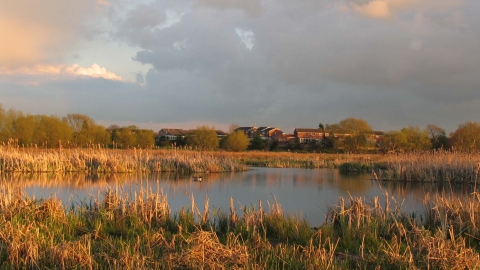
Location
Know before you go
Dogs
When to visit
Opening times
Open at all timesBest time to visit
March to May, September to DecemberAbout the reserve
Visitors to Doxey Marshes can get closer to wildlife;
Bird Hide
The reserve has two bird hides and a series of pond dipping platforms. You may need a code to access our bird hides. Please call our reception desk at The Wolseley Centre for the code. 01889 880 100 open 9.30am to 4pm.
Here are a few species to look out for from the bird hide - so grab your binoculars and get spotting!
- The rectangular hide overlooking Tillington Flash: Oystercatcher (spring); hobby (summer); shelduck (summer); goosander (autumn and winter); black tailed godwit (spring and autumn); great crested grebe (all year); little egret (all year).
Wax rubbing trail
Follow the circular trail around the centre of the reserve to find the numbered posts with rubbing plaques of some of the wildlife that lives here. Don't forget your crayons! Download your rubbing sheet at the bottom of this web page.
Take an early morning walk in spring to discover the magic of a wetland dawn chorus:
- Look and listen for Lapwing performing their tumbling display flight over the pasture in Spring, whilst calling out 'pee-wit'
- Keep an eye out for migrating birds as the reserve is well known for attracting lots of passage species and even the odd rarity!
- Visit in the winter months to see large flocks of waterfowl including wigeon and teal - birds galore!
Highlights
- Doxey Marshes is a fantastic place to discover birds with over 200 species recorded and over 80 breeding species.
- The reserve is designated a Site of Special Scientific Interest for its nationally important populations of lapwing, snipe and redshank. The reserve also attracts many rare birds every year, including the first ever cattle egret and river warbler to be recorded in the Midlands region!
Not Just Birds!
Although well known as a great bird watching location, Doxey Marshes is also home to regionally significant populations of otter, harvest mouse and water shrew. The reserve is also home to a vast array of wetland plants, including the biggest area of Reed-sweet Grass in the Midlands. In Spring the pastures are carpeted with flowers such as lady’s smock, buttercup and ragged robin.
Water, water everywhere
The reserve forms part of the River Sow floodplain so is naturally a wet area and will occasionally flood. Most of the large pools on the reserve, known locally as flashes, have formed as a result of subsidence from brine extraction in the 1950s. These flashes are a great place to find many species of water bird including Tufted Duck, Goosander and Great Crested Grebe.
Mud, Mud Glorious Mud
Across the reserve are numerous muddy depressions known as scrapes. These were created to encourage wetland birds such as Lapwing and Redshank to breed, as well as providing feeding points for migrating birds
Contact us
Environmental designation
Doxey Marshes from above (https://youtu.be/OjZ0CmVALRg?si=QQwHcMVgYxItav4B)
All footage by Martin Varley
Rubbing Sheet - pg 1
Rubbing sheet - pg 2
Fishing at Doxey Marshes
A limited number of fishing permits are available to purchase direct from Staffordshire Wildlife Trust's online shop.
A valid Environment Agency rod licence is also needed. The reserve is regularly patrolled by fishing bailiffs so please carry your documentation with you.







